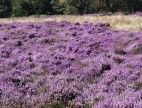
BIOLOGICAL ENVIRONMENT |
|
Plant communities |
|
Primarily dwarf-shrub dominated heathland, bracken, upland bog and flush, grassland of various types, and both semi-natural and plantation woodland. Click here to see a Phase 1 habitat survey map of Blackamoor. Communities grade into each other and intermediate types are common. Each community is summarised below and species lists for some of the communities can be found by clicking here. A fuller account of the sites vegetation can be found in Anderson (1984).
 |
Dominated by dwarf (ericaceous) shrubs, in particular heather and bilberry. Generally rather species-poor, although older stands may have developed an interesting moss and lichen flora. Heather and bilberry are locally dominant and form dense monocultures of varying ages; heather predominating in central areas and bilberry being mostly restricted to the moorland margins (in particular, within and close to the woodland in the north of the site). The most established stands of heather are on Blacka Hill to the north and south of Blacka Dyke. Older stands are woody and susceptible to intense fires.
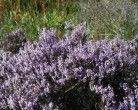 |
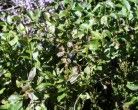 |
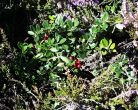 |
|
Ling |
Bilberry
|
Cowberry
|
Heather is slowly shrinking in extent as birch and bracken invade. Due to its higher light requirements the species will decline as these species expand. Bilberry and cowberry have greater shade tolerance than heather and may be less severely affected (or have greater recovery potential).
Other dwarf-shrub of these drier areas include bell heather and the nationally scarce hybrid bilberry - a hybrid between bilberry and cowberry. his occurs largely along the northern fringe of the site, west of Blacka Plantation, and is one of the best stands in the region. Damper areas support crowberry.
| Back |
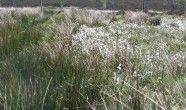 |
The most extensive bog community is dominated by dense tussocks of hare'stail cotton-grass and purple moor-grass. Trailing over the tussocks are such species as cranberry, cross-leaved heath, crowberry and heather. These species occur on the drier tussocks and in locally dry areas above sunken boulders etc. Polytrichum and Sphagnum sp. (mosses) are also constituents of these bog communities.
Wet grasslands totally dominated by purple moor-grass and small pools and flushes are also common. Flush species include cranberry, cross-leaved heath and occasionally the locally rare sundew and bog asphodel, together with Sphagnum and Polytrichum mosses. Prior to sheep grazing in the early 1980s, displays of bog asphodel were the finest in the eastern Peak District. Grazing severely reduced the asphodel population for several years. However, the population now appears to be recovering (the largest stand recorded in 1996 was approximately 20m x 10m in extent). Purple moor-grass may become problematic species, particularly in the event of fire. Protected growing points render it resistant to fire and it may become dominant, at the expense of other species.
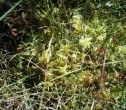 |
Smaller bog and flush communities occur below Bole Hill where the communities are similar but bog asphodel is absent. Another local rarity, lesser skullcap, was recorded from the flushes below Bole Hill in the 1970s but there are no recent records.
Soft rush-dominated vegetation is common in wetter areas. Characteristic species in these communities include greater birds-foot trefoil, devils'-bit scabious and the locally uncommon marsh pennywort and the moss (Sphagnum recurvum).
| Back |
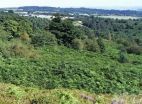 |
Bracken occurs across Blackamoor at a range of densities. Under a dense stand of heather or bilberry it is usually no more than occasional but the prevalence of fire and degenerate heather allows bracken to invade into gaps. Bracken has changed its distribution somewhat on Blackamoor during recent decades, spreading at the expense of the dwarf-shrub community (Maps showing vegetation changes in since 1971 are held at the Environmental records Centre, Sheffield City Ecology Unit).
Management of bracken stands may be problematic when the species is not totally dominant and overlies a relatively rich ground flora. Especially on shallow mineral soils, this may include adders tongue fem. This is locally uncommon and will be sensitive to Azulox spraying. As a consequence, all areas where spraying is recommended have been evaluated and only a limited programme of such work has been proposed in this plan. If a wider area is to be sprayed in future, the botanical interest must be evaluated prior to a work programme being drawn up.
| Back |
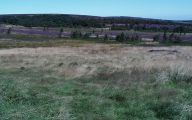 |
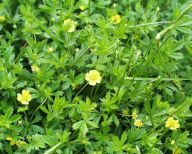 |
Most of the grassland has developed over Podzols on slopes where peat formation is restricted, and possibly in areas where grazing and 'improvement' (probably liming) has favoured grasses over dwarf shrubs (in particular around the former Medieval settlement of Strawberry Lee Farm). There is little information on the grassland communities in this area, but a recent visit by the author found sneezewort and pignut, both of which may be indications of old neutral to slightly acid meadow communities. Elsewhere, communities are typically rather species-poor acid grassland, dominated by mat grass, sheep's fescue, wavy hair-grass and bent grasses. These also include smaller amounts of heather, bilberry, common sedge, heath rush, heath wood-rush, tormentil and heath bedstraw in places. Some acid grassland may be undergoing succession to heather in the absence of grazing.
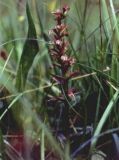 |
South of the A625 is a small area of species-rich grassland where a locally high base-status (probably the result of run off from the road over lime chippings used in the road sub-surface) has favoured grasses and herbs more usually associated with neutral or calcareous grassland. Characteristic plants include frog orchid, common twayblade, crosswort, melancholy thistle (at the southern end of its national range within the Peak District and the only Sheffield location), crested hair-grass, hairy oat-grass, quaking grass, glaucous sedge and adder's-tongue fem. Damp areas support common valerian and sneezewort. Scrub encroachment from the adjacent woodland is occurring and the area has been adversely affected by the inappropriate planting of commemorative trees. This is also a rich area for invertebrates, especially butterflies. The intimate mosaic of limestone and heathland species has some affinity with the nationally rare limestone-heath environments of the White Peak.
Grassland under the woodland canopy is dominated by a range of species characteristic of deeper, more nutrient-rich soils including cocksfoot and creeping soft-grass. There are several flushed areas alongside ditches where a rush community is present.
| Back |
| Woodland dominates the extreme north, east and south-east of Blackamoor and birch scrub is encroaching onto the formerly open moorland. Old plantations and ancient woodland remnants form the woodland cores in Strawberry Lee and Blacka Plantations and along the lower reaches of Blacka Dyke. Some areas of plantation or secondary woodland are beginning to develop their wildlife value, in particular for birds. Scrub may also have a rich invertebrate fauna and provide breeding, feeding and roost sites for birds. For the purposes of the management plan the woodland was divided in to nine blocks. The locations of these blocks are shown on the map to the right. |
|
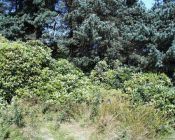 |
Succession in this block will result in eventually decline of the pine stand and loss of the relict ancient woodland as rhododendron continues to expand. This will require control if complete dominance of this species is to be avoided and the woodland is to retain its conservation interest.
The ground flora is locally species-rich and includes yellow archangel, wood sorrel and opposite-leaved saxifrage. The woodland is expected to be rich in invertebrate species characteristic of such old woodlands and dead wood habitats. The bryophyte and lichen flora may be of interest and would be worthy of closer investigation.
Further up-stream the woodland grades into low birch and willow scrub and toward the head of the block there is a small commemorative planting of red oak. This scrub is encroaching in places into the adjacent moorland.
Comprises a rowan/hawthorn valley woodland that extends for some distance along the sides of the southern-most stream. There are numerous old rowan trees, many of which appear to have been coppiced in the past. The stream itself is narrow and the sides are mostly rather dry. As a result there are few alders and the stream-side ground flora is generally poorer than for example along Blacka Dyke. There are a number of interesting flushes however, and the area would benefit from a fuller survey. The canopy is well structured in places and the woodland is diverse. Upstream, the woodland grades into birch scrub, which extends up the flanks of the valley and is encroaching into the moor above on Bolehill.
| Back |
Fauna |
There have been no systematic mammal surveys of Blackamoor to date and there are few available records. However, the grassland and woodland-edge fauna is expected to include good numbers of small rodents such as short-tailed field vole, common shrew, pygmy shrew, wood mouse and bank vole. These species in turn support birds of prey (e.g. kestrel and owls). Fox has been recorded from the site, and badger are presently active in several areas. In coming years, the dense scrub and woodlands on Blackamoor are expected to provide good cover for deer, which are known to be colonising nearby. countryside. Mountain hare occurs immediately north on Houndkirk and Burbage Moor (at its south-eastern limit) but it has not been confirmed at Blackamoor.
| Back |
The species list is varied and reflects the wide range of available habitats. Scrub species include blackcap and willow warbler, alder 'coppice' supports willow tit and tree pipit utilises the moorland/woodland fringe. With appropriate management nightjar, which breeds elsewhere in the region in low numbers (e.g. Wharncliffe), may be encouraged to breed. Woodcock are thought to breed in Blacka Plantation together with wood warbler and redstart. Strawberry Lee Plantation supports sparrowhawk, long-cared owl, redstart, several commoner tits, tree creeper, goldcrest and great spotted woodpecker. Birds of the open heathland and adjacent grassland are grouse, yellowhammer, kestrel, meadow pipit, skylark and whinchat (bracken areas). Reed bunting and snipe are characteristic of bog environments and merlin has been recorded below Bole Hill. Other occasional breeding species include short-eared owl, golden plover, redshank and curlew.
| Back |
Fauna of drier areas include colonies of common lizard (abundant). Adder are present on nearby Big Moor and have been recently reported from adjacent areas of Totley Moor (D.Whiteley, pers.comm. 1996). In light of this the species is expected to occur on Blackamoor, although there are no records as yet. There is abundant suitable habitat; sheltered sunny banks, tall dwarf-shrub heath, stream sides and woodland, and dense bracken beds.
| Back |
A range of groups including beetles, hoverflies and moths have been surveyed. Of particular note are the Lepidoptera (butterflies and moths), of which there are several locally uncommon moths including smokey wave, ling pug, narrow-winged pug and butterflies such as green hairstreak, common blue and large and small skippers. Diptera (flies) records include Sericomyia lappona, which is locally scarce. Other notable invertebrates include the timber beetle Hylecoetus dermestoides (an old woodland indicator), bilberry bumble-bee and several locally scarce hoverflies.
| Back |
Natural trends |
Much of the site is undergoing succession toward woodland as would be expected in the absence of management. Whilst scrub has some intrinsic conservation value, its uncontrolled increase is threatening important habitat types, in particular dwarf-shrub heath. Woodland has expanded into the centre of the site during the past few decades, particularly from the valley of Blacka Dyke and from the steep southern-most valley which drains toward Hall Field Farm in the east (marked Pinfold on OS maps).
Bracken is also expanding in places, at the expense of the dwarf shrub community (although at a slower rate than scrub). Areas of greatest expansion are in the north-cast, where a rather inaccessible area of mixed dwarf shrubs has been almost totally replaced, and to the south of Blacka Hill, where a small amount of invasion has occurred.
Lack of heather management promotes old, woody growth and may encourage accidental and deliberate fires. This may have serious impact on heathland regeneration as well as on populations of reptiles and other less mobile species. The isolated and small populations that result are even more susceptible to catastrophic events, and fires can wipe out locally important populations very swiftly. These may take a years to re-establish (even assuming that no further adverse disturbance takes place).
Bog and flush vegetation may have shrunk slightly in extent during the past two decades. However, change to this important habitat-type requires finer scale monitoring than can be carried out from aerial photographs. These communities require mapping in the field and their nature conservation interest evaluating as a matter of urgency.
As a result of these natural trends, the fauna of the moor is also expected to be undergoing subtle change, although these are not easily quantifiable. Expansion of the scrub and woodland will favour birds associated with later successional environments. Species associated with more open conditions will decline in proportion to loss of their habitat.
| Back |
Nature conservation evaluation |
The following section uses the standard English Nature criteria for evaluating sites of nature conservation importance:
Despite its large size, many of the most valuable habitat-types are rather restricted in extent. Cotton grass bog and flushes cover small areas (a result of local hydrological conditions) and populations of notable plants are rather low and susceptible to catastrophic events (such as damage from grazing or fire). Small habitats and small populations of less mobile reptiles, invertebrates and other species, are all at risk from such catastrophic events.
There are a range of habitat-types and species present. These include bog and flush vegetation, which are the richest communities botanically, dwarf shrub heath, old plantation woodland, relict ancient woodland, old secondary woodland and recent scrub and old bracken beds, some of which may be of considerable age. Together, these communities support a range of breeding mammals, birds, reptiles and invertebrates.
Apart from the plantation woodlands and some subsequent planting, the vegetation is largely semi-natural. The present communities reflect past management regimes; heather probably resulting from recent burning rotations, mixed dwarf-shrub heath probably from less burning and light grazing, and the grasslands from either intensive grazing or possibly from additions of lime or basic slag.
There are a number of locally scarce habitats and species. Habitat-types listed as 'At Risk' in the Sheffield Nature Conservation Strategy include alder woodland, dry heathland and species-rich flushes and bogs. Locally critical plant species listed in the strategy include common polypody, melancholy thistle and frog orchid (Grade A), heath spotted orchid, adders tongue fern, yellow rattle and hybrid bilberry (Grade B). Bog asphodel is locally scarce and the site contain extensive hybrid bilberry. There are a number of breeding birds which are listed in the Strategy: merlin is Grade A and snipe and whinchat both Grade B. Other fauna includes badger (Grade B) and common lizard (Grade B). Several invertebrates are also locally graded, including the timber beetle Hylecoetus dermestoides (Notable), moths including map-winged swift (Local), Ling pug (Local), narrow-winged pug (Local), muslin footman (Local), green hairstreak butterfly and several species of hoverfly. The ichneumon wasp Iseropus stercorator is one of only three Yorkshire records. Many invertebrate species are dependent on key habitats such as dead wood, Juncus flushes, open heather and bilberry communities, bracken beds, and tall herb communities.
Bog communities are sensitive to disturbance from fire, inappropriate grazing management and trampling by visitors. As already discussed, small populations of less mobile species are at risk from fire and ground-nesting birds can be very sensitive to disturbance by dogs. Left unmanaged, dwarf shrub heath is very susceptible to invasion by bracken and scrub, and to damage by fire
Wetland environments, particularly those dominated by hares-tail cotton grass, contain good examples of the rather species-poor bog communities, typical of this region of the Pennines. Dwarf-shrub heath is generally representative of dry moorland vegetation elsewhere in the Dark Peak.
Blackamoor is an integral part of the eastern moorland fringe of the southern Pennines and forms an important link between Totley Moss in the south-west and Houndkirk and Burbage moors to the north. Each of these moors provides a buffer for populations of plants and animals to re-colonise adjacent areas in the event of local extinction. It is also at the western end of a major 'green corridor', which runs east along the Sheaf Valley into Sheffield.
| Back |
Assessment of Site features |
|
Site features |
Importance |
||
|
National |
Regional |
Local |
|
|
Vegetation types |
|
|
|
|
Dwarf-shrub communities |
|
|
High |
|
Bracken stands |
|
|
Average |
|
Heathland flush and bog |
|
Good |
|
|
Woodland (scrub) |
|
|
Average |
|
Woodland (plantation) |
|
|
Average |
Plants species |
|
|
|
|
common polypody fern |
|
Good |
|
|
bog bean |
|
High |
|
|
bog asphodel |
|
High |
|
|
heath spotted orchid |
|
|
High |
|
hybrid bilberry |
High |
|
|
|
cranberry |
|
|
Good |
|
lesser skullcap (may be lost from site) |
|
High |
|
|
melancholy thistle |
|
|
High |
|
sundew |
|
High |
|
|
common twayblade |
|
|
High |
|
hairy oat-grass |
|
|
High |
|
crested hair-grass |
|
|
High |
|
yellow rattle |
|
|
Good |
|
adder's tongue fern |
|
|
Good |
|
fog orchid |
|
|
High |
4. Birds, mammals, reptiles |
|
|
|
|
long-eared owl |
|
Good |
|
|
Snipe |
|
|
Good |
|
whinchat |
|
|
Good |
|
badger |
|
|
Good |
|
adder(probable) |
|
High |
|
|
common lizard |
|
|
Good |
5. Invertebrates |
|
|
|
|
smokey wave (moth) |
|
Good |
|
|
muslin footman (Moth) |
|
Good |
|
|
map-winged swift (moth) |
|
|
Good |
|
narrow-winged pug (moth) |
|
|
Good |
|
green hairstreak (butterfly) |
|
|
Good |
|
Bilberry bumble bee |
|
Good |
|
|
Platycherirus tarsalis |
|
|
Good |
|
Dasysrphus lunulatus |
|
|
Good |
|
Sphaerophoria fatarum |
|
|
Good |
|
Iseropus stercorator |
|
High |
|
|
Hylecoetus dermestoides |
|
|
High |
| Top |